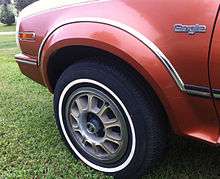Kraton (polymer)
Kraton is the trade name given to a number of high performance elastomers manufactured by Kraton Polymers (NYSE: KRA), and used as synthetic replacements for rubber. Kraton polymers offers many of the properties of natural rubber, such as flexibility, high traction, and sealing abilities, but with increased resistance to heat, weathering, and chemicals. It was first made by the chemical division of the Shell Oil Company in the 1950s,[1] under the technical leadership of Murray Luftglass and Norman R. Legge.[2] Shell sold its Kraton polymers business to private equity firm Ripplewood Holdings in March 2001.[3]
| Traded as | NYSE: KRA S&P 600 Component |
|---|---|
| Website | kraton |
Properties

Kraton polymers are styrenic block copolymer (SBC) consisting of polystyrene blocks and rubber blocks. The rubber blocks consist of polybutadiene, polyisoprene or their hydrogenated equivalents. The tri-block with polystyrene blocks at both extremities linked together by a rubber block is the most important polymer structure observed in SBC. If the rubber block consist of polybutadiene, the corresponding triblock structure is: poly(styrene-block-butadiene-block-styrene) usually abbreviated as SBS. Kraton D (SBS and SIS) and their selectively hydrogenated versions Kraton G (SEBS and SEPS) are the major Kraton polymer structures. The microstructure of SBS consists of domains of polystyrene arranged regularly in a matrix of polybutadiene, as shown in the TEM micrograph. The picture was obtained on a thin film of polymer cast onto mercury from solution, and then stained with osmium tetroxide.
The glass transition temperature (Tg) of the polybutadiene blocks is typically −90°C and Tg of the polystyrene blocks is +100°C. So, at any temperature between about −90°C and +100°C Kraton SBS will act as a physically crosslinked elastomer. If Kraton polymers are heated substantially above the Tg of the styrene-derived blocks, that is, above about 100°C, like 170°C the physical cross-links change from rigid glassy regions to flowable melt regions and the entire material flows and therefore can be cast, molded, or extruded into any desired form. On cooling, this new form resumes its elastomeric character. This is the reason such a material is called a thermoplastic elastomer (TPE). The polystyrene blocks form domains of nanometre size in the microstructure, and they stabilise the form of the moulded material. Depending on the rubber to polystyrene ratio in the material, the polystyrene domains can be spherical or form cylinders or lamellae. The hydrogenated Kraton polymers named Kraton G exhibit improved resistance to temperature (processing at 200–230°C is common), to oxidation and to UV. SEBS and SEPS due to their polyolefinic rubber nature present excellent compatibility with polyolefins and paraffinic oils.
Applications
Kraton polymers are always used in blends with various other ingredients like paraffinic oils, polyolefins, polystyrene, bitumen, tackifying resins, fillers to provide a very large range of end-use products ranging from hot melt adhesives to impact modified transparent polypropylene bins, from medical TPE compounds to modified bitumen roofing felts or from oil gel toys (including sex toys) to elastic attachments in diapers.
It can make asphalt flexible, which is necessary if the asphalt is to be used to coat a surface that is below grade or for highly demanding paving applications like F1 racing tracks.
Kraton based compounds are also used in non-slip knife handles.

The earliest commercial components using Kraton G (thermoplastic rubber) in the automobile industry were in 1975.[4] American Motors (AMC) used this polymer plastic on the AMC Eagle for the color matched flexible wheel arch flares that flowed into rocker panel extensions.[5]
Some grades of Kraton can also be dissolved into hydrocarbon oils to create "shear thinning" grease type products that are used in the manufacture of telecommunications cables containing optical fibres.
References
- "CEO's message". Kraton Polymers. Retrieved 4 November 2012.
- Hsieh, Henry; Quirk, Rodney (1996). Anionic Polymerization: Principles and Practical Applications. CRC Press. p. 480. ISBN 9780824795238. Retrieved 19 August 2017.
- Cousins, Keith (2001). Polymers for Electronic Components. Rapra Technology. p. 101. ISBN 9781847351982. Retrieved 4 November 2012.
- Thermoplastic elastomers II: Processing for performance: Papers from a one-day seminar, Volume 2. iSmithers Rapra Technology. 1989. ISBN 9780902348417. Retrieved 29 January 2017.
- Cranswick, Marc (2012). The Cars of American Motors: An Illustrated History. McFarland. p. 270. ISBN 978-0-7864-4672-8. Retrieved 29 January 2017.
A plastic polymer material bearing the trademark name "Kraton" was used for the wheel well extenders, rocker moldings and lower door panel protectors.
- Lewis, PR (January 1972). "Electron Microscopy of sym-SBS block polymers". Polymer. 13 (1): 20–26. doi:10.1016/0032-3861(72)90030-4.
- Kraton G SEBS and SEPS polymer official data documents and applications, retrieved on 6 May 2017.